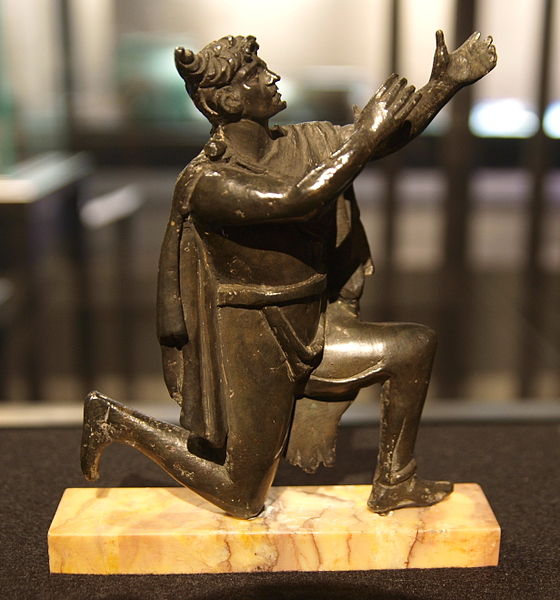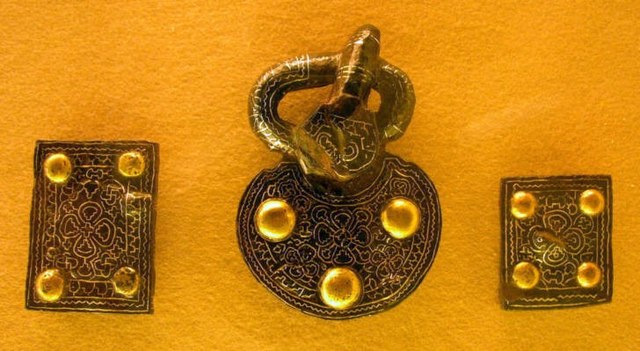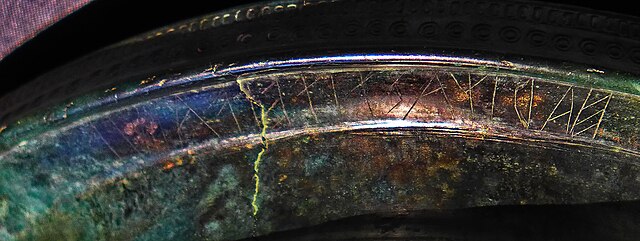The Alemanni or Alamanni were a confederation of Germanic tribes on the Upper Rhine River during the first millennium. First mentioned by Cassius Dio in the context of the campaign of Roman emperor Caracalla of 213, the Alemanni captured the Agri Decumates in 260, and later expanded into present-day Alsace and northern Switzerland, leading to the establishment of the Old High German language in those regions, which by the eighth century were collectively referred to as Alamannia.
Alemannic belt mountings, from a seventh-century grave in the grave field at Weingarten
The Limes Germanicus 83 to 260 CE
The gold bracteate of Pliezhausen (sixth or seventh century) shows typical iconography of the pagan period. The bracteate depicts the "horse-stabber underhoof" scene, a supine warrior stabbing a horse while it runs over him. The scene is adapted from Roman era gravestones of the region.
The seventh-century Gutenstein scabbard, found near Sigmaringen, Baden-Württemberg, is a late testimony of pagan ritual in Alemannia, showing a warrior in ritual wolf costume, holding a ring-spatha.
The Germanic peoples were historical groups of people that once occupied Northwestern and Central Europe and Scandinavia during antiquity and into the early Middle Ages. Since the 19th century, they have traditionally been defined by the use of ancient and early medieval Germanic languages and are thus equated at least approximately with Germanic-speaking peoples, although different academic disciplines have their own definitions of what makes someone or something "Germanic". The Romans named the area belonging to North-Central Europe in which Germanic peoples lived Germania, stretching east to west between the Vistula and Rhine rivers and north to south from southern Scandinavia to the upper Danube. In discussions of the Roman period, the Germanic peoples are sometimes referred to as Germani or ancient Germans, although many scholars consider the second term problematic since it suggests identity with present-day Germans. The very concept of "Germanic peoples" has become the subject of controversy among contemporary scholars. Some scholars call for its total abandonment as a modern construct since lumping "Germanic peoples" together implies a common group identity for which there is little evidence. Other scholars have defended the term's continued use and argue that a common Germanic language allows one to speak of "Germanic peoples", regardless of whether these ancient and medieval peoples saw themselves as having a common identity. While several historians and archaeologists continue to use the term "Germanic peoples" to refer to historical people groups from the 1st to 4th centuries CE, the term is no longer used by most historians and archaeologists for the period around the Fall of the Roman Empire and the Early Middle Ages.

Roman bronze statuette representing a Germanic man with his hair in a Suebian knot. Dating to the late 1st century – early 2nd century A.D.
The inscription on the Negau helmet B, carved in the Etruscan alphabet during the 3rd–2nd c. BCE, is generally regarded as Proto-Germanic.
Replica of an altar for the Matrons of Vacallina (Matronae Vacallinehae) from Mechernich-Weyer, Germany
The Roman province of Germania, in existence from 7 BCE to 9 CE. The dotted line represents the Limes Germanicus, the fortified border constructed following the final withdrawal of Roman forces from Germania.








